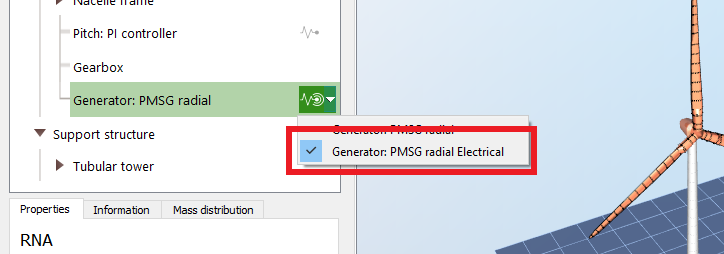Generator [Electrical] sensor
It is possible to add a sensor to the generator to obtain certain electrical output, by opening the Generator sensor dropdown menu and selecting
Generator [electrical]
, as shown in the image below. The algorithms/formulas used to calculate the output of this sensor is not yet documentd in the Theory manual. However, it is currently documented in a spreadsheet that is available to NTNU students.

This sensor only provides information for Generator of type
Permanent Magnet Synchronous Generators (PMSG)
. For other types of generators it will only output zeroes.
The
Generator [electrical]
sensor provides the following fields:
| Field | Unit | Description |
| Voltage (induced) per phase (EMF) | V | EMF = Electromotive force. Cannot be measured directly. https://en.wikipedia.org/wiki/Electromotive_force |
| Voltage (terminal) per phase | V | The output voltage. Can be measured. The voltage is always smaller than the EMF because of internal losses (resistance). |
| Current per phase | Amp | The output current of the generator per phase. Can be measured. Proportional with the induced voltage (EMF). |
| Frequency | Hz | The frequency of the AC elecricity (voltage and current) that is produced by the generator. Proportional with the RPM and the number of poles. |
| Maximum power | kW | The maximum power that is physically possible given the current design, RPM and optimal load. |
| Resistance for maximum power (and torque) | ohm | This is the load resistance that would give the maximum torque and power output from the generator, given that the input power to the generator is sufficient. In our case, the input power to the generator is limited by the mechanical power output from the rotor. This is therefore typically not the load resistance that will give the maximum power output from the wind turbine (generator and rotor together). |
| Stator coil resistance per phase | ohm | Proportional to the stator coil inductance and electrical angular velocity. |